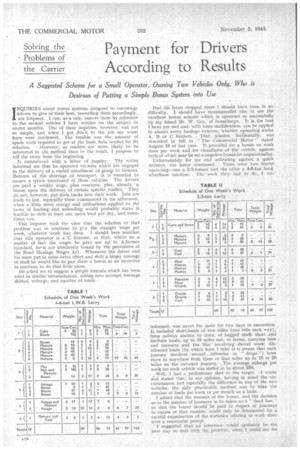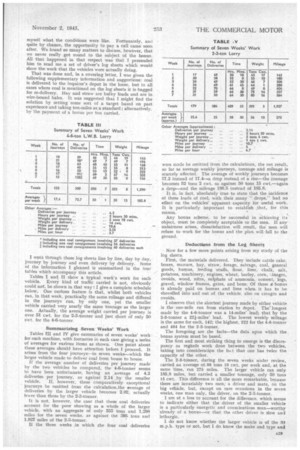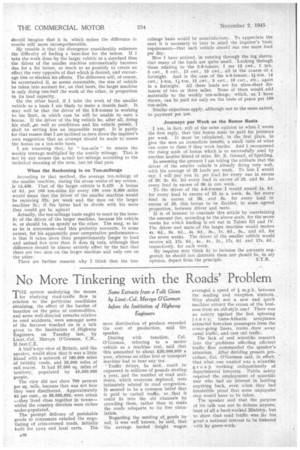Payment for Drivers According to Results
Page 30

Page 31

Page 32

If you've noticed an error in this article please click here to report it so we can fix it.
INQUMIES about bonus systems designed to encourage drivers to give of their best, rewarding them accordingly, are frequent. I can, as a rule, answer them by reference to the several articles I have -written on the subject in recent months. One of these inquiries, however, was not so simple, and when I got down to the job my worst fears were confirmed. The trouble was the amount of. spade work required to get at the basic data needed for its solution. 'However, as readers are more likely to be interested in the method than in the result, I propose to tell the story from the beginning.
It commenced with a letter of inquiry. The writer informed me that he operated veticles which are engaged in the delivery of a varied assortment of good; to farmers. Because of the shortage of transport, it is essential to ensure a quick turnround of these vehicles: The drivers are paid a weekly wage, plus overtime, plus, alreadY, a bonus upon the delivery of certain specific traffics. They do not, however, put their backs into their work. jobs are made to last, especially those commenced in the afternoon, when a little more energy and enthusiasm applied to the tasks of loading and unloading would probably make it . feasible to shift at least one extra load per day, and sometimes two.
This inquirer took the view that the solution of that problem was to continue to p" .y the straight wage per week, whatever work was done, I should here mention that this operator is a C licensee, so that, whilst as a matter of fact the Wages he pays are up to A-licence 'standard, he-is not absolutely bound by the provisions of the Road Haulage Wages Act. Whenever the driver and his mate put in some extra effort and shift a larger tonnage of stuff he would, like to pay them a bonus as an incentive to continue to do that little more.
He asked me to suggest a simple formula which has been tried in similar circumstances, taking into account tonnage shifted, mileage, and number of loads. Had his letter stopped there I should have been in no difficulty. I should have recommended him to use the excellent bonus scheme which is operated so successfully by my friend Mr. W. Goy, of Scunthorpe. It is the best I have yet met and, with some modification, can be applied to almost every haulage concern, whether operating under A, B or C licences. That scheme, incidentally, was described in full in . " The Commercial Motor" dated August 18 of last year. It provided for a bonus on work done per week and for cleanliness of the vehicle, against both of which may be set a negative bonus for unpunctuality.
Unfortunately for me and militating against a quick decision, the letter continued. There were two lorries operating—one a 2-3-tonner and the other a 4-6-ton.longwheelbase machine. The work they had to do, I was informed, was never the same for two days in succession. It included short-hauls of two miles (one mile each way), from railway station to store, of bagged stuff; short and medium hauls„ up to 15 miles out, to farms, carrying lime and manures and the like,involving shovel work; distribute&loads (by which term I infer it is Meant that each journey involves several deliveries or " drops ") from store to anywhere frojn three or four miles up to 15 or 20 miles on the outward journey. The average mileage per week for each vehicle was stated to be about 250.
Well, I had a preliminary shot at the target. I wrote and stated that, in my opinion, having in mind the circumstances and especially the difference in size of the two vehicles, the only practicable method was to take the number of loads per week or per month as a basis. I added that the amount of the bonus, and the decision as to the number of journeys to be taken as a " dead line," so that the bonus should be paid in respect of johrneys in excess of that number, could only be determined by a careful examination of the statistics relating to work done over a reasonable period. I Suggested that an interview would probably be the best way to deal with the problem, when I could see for myself what the conditions were like. Fortunately, ane quite by chance, the opportunity to pay a call came soon after. We found so many matters to discuss, however, that we never really got round to the subject of the bonus. Ail that happened in that respect was that I persuaded him to send me a set of driver's log sheets which would show the work that the vehicles were actually doing. That was done and, in a covering letter, I was given the following supplementary information and suggestions: coal is delivered to the inquirer's depot in the loose, but in all cases where coal is mentioned on the log sheets it is bagged for re-delivery. Hay and straw are bulky loads and are in wire-bound bales. It was suggested that I might find the solution by setting some sort of a target based on past experience and taking ton-miles as.a standard; alternatively, by the payment of a bonus per ton carried.
I went through those log sheets line by line, day by day, journey by journey and even delivery by delivery. Some of the information I gleaned is summarized in the four tables which accompany this article.
Tables I and II show a typical week's work for each vehicle. Every kind of traffic carried is not, obviously could not, be shown in that way : I give a complete schedule below, One curious feature is that, whilst both vehicles ran, in that week, practically the same mileage and differed in the journeys run, by only one, yet the smaller vehicle carried very nearly the same tonnage as the larger one. Actually, the average weight carried per journey is Over 51 cwt. for the 2-3-tonner and just short of only 50 cwt. for the 4-6-tonner.
Summarizing Seven Weeks' Work
Tables III and IV give summaries of seven weeks' work for each machine, with footnotes in each case giving a series of averages for various items as shown. One point about these averages should have attention before I proceed. It arises from the four journeys—in seven weeks—which the larger vehicle made to deliver coal from house to house.
If the average number of deliveries per journey made by the two vehicles be compared, the 4-6-tonner seems to have been unfortunate, having an average of 4,2 deliveries per journey, as against 2.14 by the smaller vehicle. If, however, these comparatively exceptional journeys be omitted from the calculation,the erverage of deliveries by the larger vehicle becomes 2.02, actually fewer than those by the 2-3-tonner.
It is not, however, the case that the coal deliveries account for the poor showing as a whole of the larger vehicle, with an aggregate of only 355 tons and 1,298 miles for the seven weeks, as against the 394 tons and 1,927 miles of the 2-3-tonner.
If the three weeks in which the four coal deliveries • were made be omitted from the calculations, the net result, so far 38 average weekly journeys, tonnage add mileage is scarcely affected. The average of weekly journeys becomes 17.2 instead of 17.4—,-a drop instead of a rise—the fonnage becomes 52 tons 2 cwt, as against 50 tons 15 cwt.—again a drop—and the mileage 186.5 instead of 185.8. It is, in fact, absolutely true to state that the incidence of these loads of coal, with their many " drops," had no effect on the vehicles' apparent capacity for useful work. It is particularly important to establish _that, for this reason.
Any bonus scheme, to be successful in achieving irs object, must be completely acceptable to the men. If any — unfairness arises, dissatisfaction will result, the men will refuse to work for the bonus and the plan will -fall to the ground.
Deductions from the Log Sheets Now for a few more points arising from my study of the log sheets. First, the materials delivered. They include cattle cake, boxes, manure, hay, straw, forage, salvage, coal, general goods, humus, feeding -stuffs, flour, lime, chalk, salt, potatoes, machinery, engines, wheat, barley, corn, finagro, ovoids, wood, nitre, sulphate of ammonia, cement, logs, gravel, window frames, gates, and bone. Of these a bonus is already paid on humus and lime when it has to be shovelled into and out of the vehicle, also on cinagro and ovoids, I observe that the shortest journey made by either vehicle is the one-mile run from station to depot. The' longest made by the 4-6-tonner was a 14-miles' lead; that by the 2-3-tonner a 224-miles' lead. The lowest weekly mileage is the same for each, 142; the highest, 222 for the 4-.6-tonner and 404 for the 2-3-tonner.
The foregoing are the facts—the data upon which the bonus system must be based.
The first and most striking thing to emerge is the discrepancy as regards work done between the two vehicles, taking into consideration the fact that one has twice the capacity of the other.
The 2-3-tanner, during the seven weeks under review, carried an average of. 56 tons 10 cwt, per week and, at the same time, ran 275 miles. The larger vehicle ran only 185.8 miles, but carried a smaller tonnage, only 50 tons 15 cwt. This difference is all the more remarkable, because there are invariably two men; a driver and mate, On the big vehicle, but, except on rare occasions in the seven weeks, one man only, the driver, on the 2-3-tonner.
I am at a loss to account for the difference, which seems to indicate either that the driver of the smaller vehicle is a particularly energetic and conscientious man—worthy already of a bonus—or that the other driver is slow and lethargic..
I do not know whether the larger vehicle is of the 30 m.p.h. type or not, but I do know the make and type and
should imagine that it is, which makes the difference in results still more incomprehensible.
My trouble is that the divergence considerably enhances the difficulty of finding a base-line for the bonus. If 1 take the work done by the larger vehicle as a standard then the driver of the smaller machine automatically becomes due for a fat bonus, so much so as possibly to create an effect the very opposite of that which is desired, and encourage him to slacken his efforts. The difference will, of course, be accentuated if, as seems reasonable, the size of vehicle be taken into account for, on that basis, the larger machine is only doing one-half the work of the other, in proportion to its load capacity.
On the other hand, if I take the work of the smaller vehicle as a basis I am likely to make a double fault. It may well be that the driver of the 2-3-tonner is working to his limit, in which case he will be unable to earn a bonus. If the driver of the big vehicle be, after all, doing his stuff, ..so well as conditions and his vehicle permit. I shall be setting him an impossible target. It is partly for that reason that I am inclined to.turn down the inquirer's own suggestion that an attempt should be made to assess the bonus on a ton-mile basis.
I am assuming that,. by " ton-mile " he means the weekly tonnage multiplied by the weekly mileage. That is not by any means the actual ton-mileage according to the technical meaning of the term, but let that pass.
When the Reckoning is on Ton-.mileage According to that method, the average ton-mileage of the smaller machine, during the seven weeks of my review, Is 15,438. That of the larger . vehicle is 9,429. A bonus of 6d. per .100 ton-miles for every 100 over 9,000 miles would mean that the driver of the smaller machine would be receiving 32s. per week and the man on the larger machine 2s.; if the latter had -to divide with his mate they would get Is. apiece!
Actually, the ton-mileage basis ought to react to the benefit of the driver of the larger machine, because his vehicle is, or should be, as speedy as the other. The snag, so far as he is concerned—and this probably accounts, to some extent, for his apparently poor comparative performance—. is that it takes more than proportionately longer to load and unload five tons than it does 21 tons, although that difference should be almost entirely offset by the fact that there are two men on the larger machine and only one on the other.
There are further reasons why I think that the ton
mileage basis would be unsatisfactory. To appreciate the next it is necessary to bear in .mind the inquirer's basic requirement—that each vehicle should run one more load per day.
Now I have noticed, in running through the log sheets, that many, of the loads are quite small. Looking through those relating to the 2-3-tonner, I see 12 cw.t., 1 ton, 3 cwt., 2 cwt., 13 cwt., 15 cwt., all in the course of a fortnight. And in the case of the 4-6-tonner,. 1i-ton, 14 cwt., 1-ton, 11-ton, 15 cwt., 5 cwt., 10 cwt., etc., again in a fortnight. All these loads are for ultra-short distances of two or three miles. None of them would add materially to the weekly ton-mileage, which, as I have shown, can be paid for only on the basis of pence per 100 ton-miles.
Similar objections apply, although not to-the same extent, to payment per ton.
Journeys per Week as the Bonus Basis
I am, in fact, still of the same opinion as when I wrote the first reply, that this bonus must be paid for journeys per week. It must be calculated, in the first place, to give the men an immediate benefit, a small taste of what can come to them if they work harder. And I recommend the rising scale of bonus which is so successfully used by another haulier friend of mine, Mr. E. Ground,_ of Spalding. In assessing the amount I am taking the attitude that the driver of the smaller vehicle is already doing very well, with his average of 25 loads per week. To him I would say: I will pay you ls. per load for every one in excess of 20; 2s. 6d. for every load in excess of 25, and 5s. for every load in excess of 30 in one week.
To the driver of the 4-6-tonner I would award Is. 6d. for every load in excess of 15 in a week, 4s. for every load in excess of 20, and 8s. for every load in excess of 25, this bonus to be divided, in some agreed proportion, between driver and mate.
It is of interest to conclude this article by ascertaining the amount due, according to the above scale, for the seven weeks for which loading is set Out in Tables III and IV.
The driver and mate.of the larger machine would receive 4s. 6d., 9s. 6d., 45. 6d., 3s., 4s. 6d., 3s., and nil, for the seven weeks, The driver of the smaller vehicle would receive nil, 12s. 6c.I., 4s., 4s., 2s., 17s. 6d. and 17s. 6d., respectively, for each week.
My inquirer may think fit to increase the amounts suggested; he should not diminish them nor should he, in my opinion, depart from the principle. S.T.R.




















































